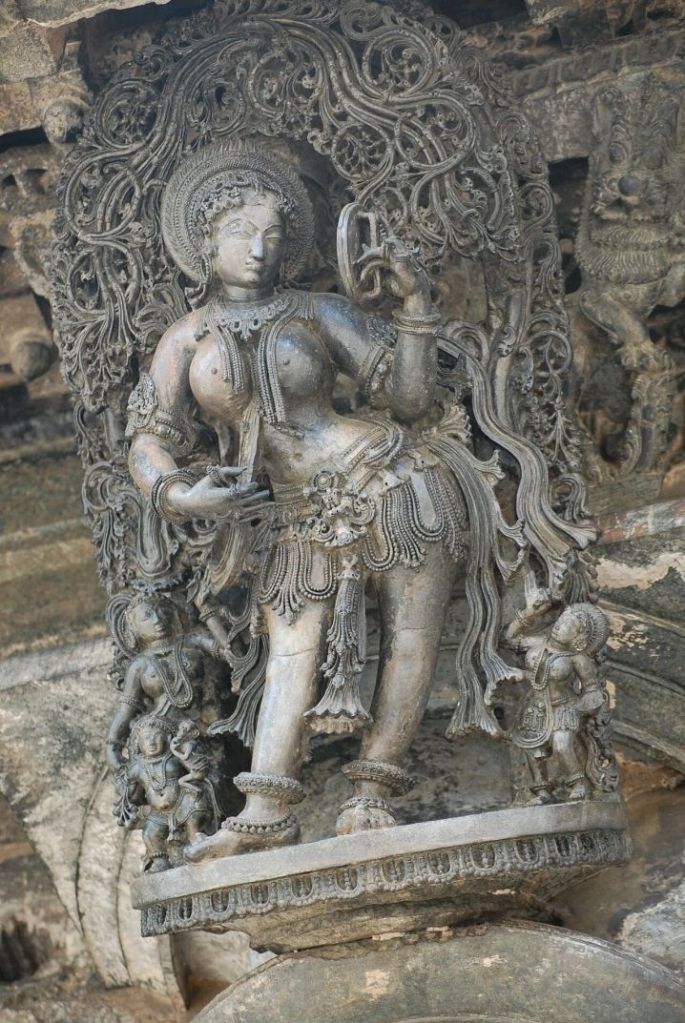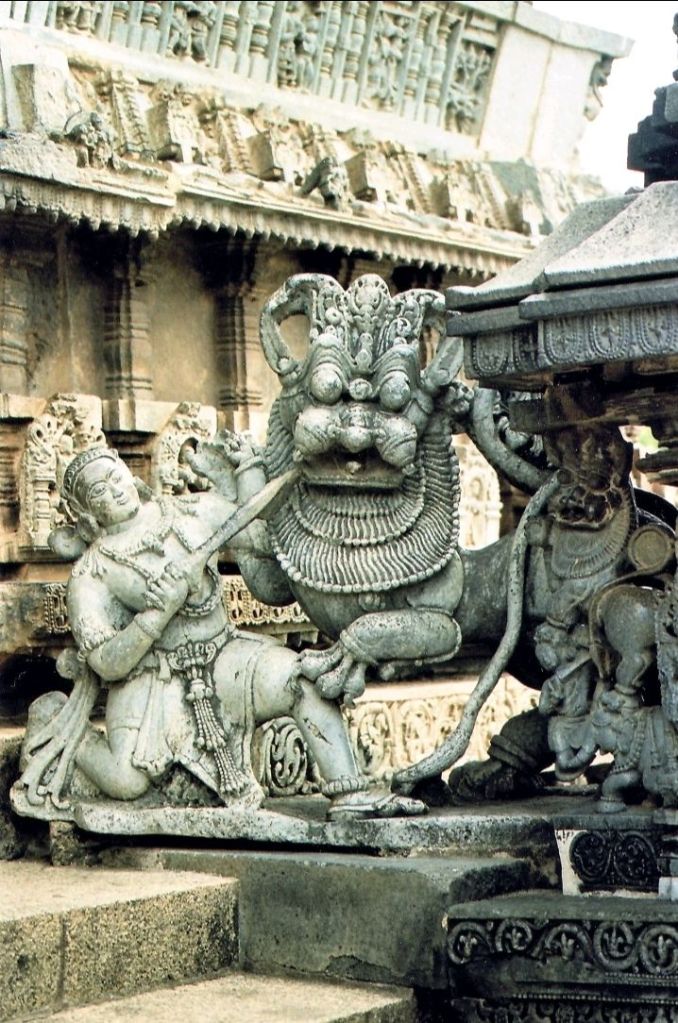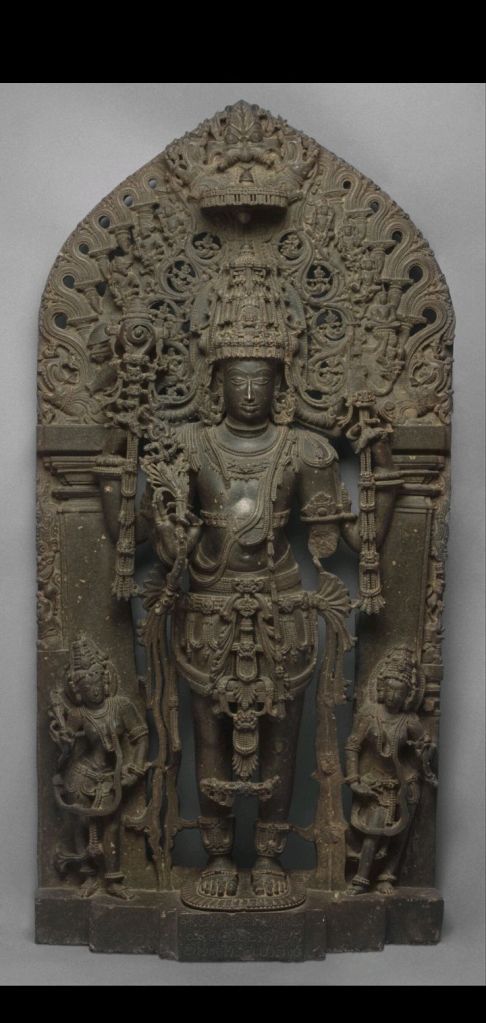
HOYSALA DYNASTY
The HOYSALA DYNASTY ruled over KANNADIGA region , now KARNATKA , between the 10th and 14th century AD .The capital of HOYSALAS was initially located at BELUR and later it became HALEBIDU and TIRUVANNAMALAI . Common languages of the people were KANNADA and SANSKRIT . HINDUISM and JAINISM prevailed among the masses . NIRPA KAMA II was the earliest king of the HOYSALA EMPIRE from the MALNAD region of KARNATKA from 1026 AD to 1047 AD . He might possibly be a vassal of the WESTERN GANGA DYNASTY . In the 12th century AD , taking advantage of the internecine warfare between the WESTERN CHALUKYA EMPIRE and KALACHURI of KALYANI , the HOYSALAS annexed the areas of present-day KARNATKA and the fertile areas north of the KAVERI DELTA of TAMILAKAM . By the 13th century AD , they not only governed KARNATKA and north-western TAMIL NADU but the western ANDHRA PRADESH in the DECCAN PLATEAU also . Ruled from around 1000 AD to 1346 AD , HOYSALAS were preceded by the WESTERN CHALUKYA EMPIRE and when disestablished in 1346 AD , they were succeeded by the VIJAYANAGAR EMPIRE .The HOYSALA era was important for the development of art , architecture and religion . More than hundred surviving temples are scattered across KARNATKA which belong to the HOYSALA period of the history of the South INDIA . They include CHENNAKESHAVA TEMPLE of BELUR , the HOYSALESWARA TEMPLE of HALEBIDU and CHENNAKESAVA TEMPLE of SOMNATHAPURA . Moreover, they also patronized fine arts and encouraged literature of KANNADA and SANSKRIT to flourish in KARNATKA .

LEGENDARY BEGINNING OF HOYSALAS
KANNADA folklore tells a legend of a young man , named as SALA or POYSALA , who saved his JAIN GURU SUDATTA by killing a tiger in a forest , near the temple of the Goddess VASANTIKA at ANGADI . Since the word strike is translated into old KANNADA as HOY , hence the name HOY-SALA .The BELUR inscription of the HOYSALA king VISHNUVARDHANA of 1117 AD , clearly state how SALA became the founder of the HOYSALA DYNASTY . VISHNUVARDHANA achieved a victory over the CHOLAS at TALAKADU in 1116 AD , the legend got popularity after this event . HOYSALA emblem also depicts SALA fighting a tiger. Here one should know that the tiger was the emblem of the CHOLAS . However , the early inscriptions dated 1078 AD and 1090 AD implied that the HOYSALAS were descendants of the YADU of CHANDRAVAMSHA lineage . Historically speaking , the HOYSALAS originated from the WESTERN GHAT mountains northwest of GANGAVADI of MYSORE . During the conflict between the WESTERN CHALUKYAS and the CHOLAS , as a chieftain the HOYSALAS sided with the former , so made Provincial Governors . After the authority of the CHALUKYAS declined , the HOYSALAS achieved the status of real kingdom under VISHNUVARDHANA . He annexed GANGAVADI and part of NOLAMBAVADI from the CHOLAS in 1116 AD and moved the capital from BELUR to HALEBIDU . After taking TALAKADU and KOLAR in 1116 AD , VISHNUVARDHANA assumed the title TALAKADUGONDA in the memory of his victory . His grandson VEERA BALLALA II during the first 20 years of his reign , freed HOYSALAS from the domination by the CHALUKYA . He declared war against the YADAVAS and defeated KADAMBAS . He declared independence in 1193 AD . In 1217 AD , VEERA BALLALA II defeated the aggressive PANDYAS after they invaded the CHOLA kingdom and the CHOLA king was to restore his kingdom .

HOYSALA SOUTHWARD HEGEMONY
Around 1225 AD , HOYSALAS extended their foothold in TAMIL NADU , making KUNNANUR KUPPAM a Provincial capital and taking control over the Southern DECCAN REGION . From 1220 to 1245 AD , HOYSALAS’ hegemony increased southwards to cover both the CHOLA and PANDYA kingdoms . At the end of the 13th century AD , VEERA BALLALA III recaptured territory in TAMIL NADU which had been lost during a PANDYA uprising . When large areas of northern INDIA was under MUSLIM rule in the early 14th century , major political changes took place in the DECCAN REGION . ALAUDDIN KHALJI , the then SULTAN of DELHI , sent his Commander MALIK KAFUR in 1311 AD on an expedition to plunder DEVAGIRI , the capital city of the SEUNA kingdom . By 1318 AD , the SEUNA kingdom had been subjugated .The HOYSALA capital HALEBIDU was besieged and sacked twice in 1311 AD and 1327 AD . In 1336 AD , the SULTAN of DELHI had conquered the PANDYA of MADURAI , the KAKATIYAS of WARANGAL and a small kingdom of KAMPILI . However, HOYSALAS were the only HINDU kingdom which resisted the invading armies . From TIRUVANNAMALAI VEERA BALLALA III offered stiff resistance to invasions from the north and the MADURAI SULTANATE to the south . After three decades of resistance , VEERA BALLALA III was killed in 1343 AD at the battle of MADURAI .The HOYSALA EMPIRE was merged with the areas administered by HARIHARA I ,the founder of the VIJAYANAGARA EMPIRE . It was this new HINDU EMPIRE that resisted tooth and nail to the northern invasions .

NOTE : THE SOURCES OF THE BLOG ARE TEXT BOOKS AND OTHER WRITTEN MATERIALS ON THE SUBJECT .
TO BE CONTINUED ………………
Well researched post. Thanks for sharing.
LikeLiked by 1 person
Thanks !
LikeLiked by 1 person
❤
LikeLiked by 1 person
Thank you so much for sharing another interesting and well-researched article
LikeLiked by 1 person
Mountain forests in India are indispensable to the country’s ecological and economic well-being. They offer a myriad of ecosystem services, from preserving biodiversity and regulating climate to supporting water resources and local livelihoods. Protecting and sustainably managing these forests is essential for maintaining their ecological integrity and ensuring the well-being of future generations.
https://www.indianetzone.com/40/mountain_forests_india.htm
LikeLiked by 1 person